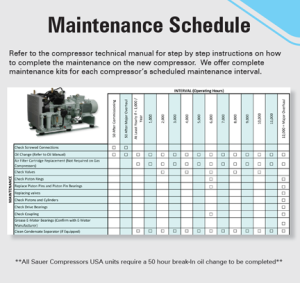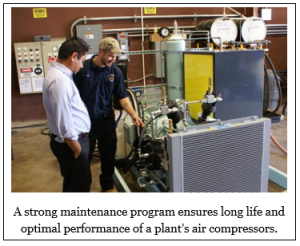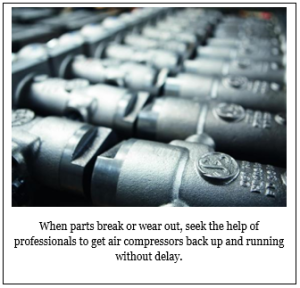Your industrial compressed air and gas system constitutes a major investment and a significant contributor to operating efficiently and productively. Keeping your air compressor in peak condition should be high on your list of maintenance activities. Fortunately, these industrial workhorses do not require a lot of costly or time-consuming resources to keep performing year after year. Still, performing a few routine checks, tests, cleanings, and adjustments will go a long way toward keeping your air and gas compressors in fine condition, generating a host of benefits:
- Maximum uptime – Scheduled and preventive maintenance can keep downtime to a minimum, so your facility continues humming along with revenue-generating activities.
- Energy efficiency – A well-tuned air compressor is an efficient air compressor. It requires less energy to do its job. The money you save can be used to line your pockets and build your business.
- Longer life – Air compressor maintenance is a cheap insurance policy. Spending a little each month on maintenance mitigates the risk of a catastrophic failure costing you thousands of dollars in repair or replacement costs.
- Operator safety – Ensuring your air compressor is well lubricated, the filters are clean, and parts are in working order will reduce heat, vibration, and the possibility of malfunction that can injure workers.
- Proper industrial air compressor maintenance falls into four broad categories: filtration, lubrication, inspection, and stabilization. All control contaminants and ensure air quality, keep the machinery running smoothly, eliminate conditions that detract from performance and reduce the chances of faults by maintaining the proper operational environment.
Filtration: Protection Against Contaminants
The air we breathe contains millions of particles of dirt in every lungful. Thankfully, our cilia and mucus membranes do a pretty good job of keeping these dust specs from getting into places where they do us harm. But the contaminants in ambient air become much more of a problem when that air is compressed. Water vapor, abrasive solids, and other nasty bits get squeezed together to form masses that can obstruct lines, cause valves to malfunction, and inflict unnecessary wear on air compressor components. In addition, the air compressors themselves can unleash oils and other unhealthy bits into the airstream.
where they do us harm. But the contaminants in ambient air become much more of a problem when that air is compressed. Water vapor, abrasive solids, and other nasty bits get squeezed together to form masses that can obstruct lines, cause valves to malfunction, and inflict unnecessary wear on air compressor components. In addition, the air compressors themselves can unleash oils and other unhealthy bits into the airstream.
Left unchecked these atmospheric and internal pollutants will limit air compressors’ effectiveness, increase energy consumption, and force you to replace parts prematurely. It is imperative to remove these contaminants from the compressed air or gas before and during use.
- Inlet filter cartridges – The equipment’s first line of defense, the air inlet filter grabs contaminants as the air compressor sucks in outside air and forces it in a downward spiral through the intake component. The inlet filter picks off contaminants and sends the now mostly clean air onto the actual compression part of the operation. As the filter cleans the air by latching onto dirt and grime, the filter naturally becomes dirty and grimy itself, making it less and less effective. Cleaning the vents weekly and installing new filters per manufacturer recommendations makes the air compressor’s job easier, improves energy efficiency, and does much of the heavy lifting for filtration stations further down the line. Inlet and airline filters should be changed when their efficiency becomes compromised. A reduction of a few psi is enough to make replacement a worthwhile investment to save energy and air compressor wear. If you can’t measure this with a differential gauge, replace the filters every 1,000 or 2,000 operating hours (depending on the air compressor series) as per the air compressor series-specific maintenance interval table provided; or sooner in heavier-use environments.
- Airline filters – Connected directly to air compressors and dryers, these filters form an integral part of the air-cleaning systems. Airline particulate filters work as obstacle courses, forcing the air through a series of sharp turns and tight spaces. The solids left over from the air’s passage through the inlet filter aren’t nimble enough to negotiate all the hurdles and contortions, eventually getting hung up in the filter’s fibers. Other airline filters specialize in trapping vapors and aerosols. Coalescing filters work by collecting liquids into larger droplets. Too heavy to be borne by the air, they convert into moisture traps on the bottom of the unit. Less common, absorption filters use carbon or another media to chemically bond with lubricants, and gasified compounds to prevent their escape.
- Drain traps – As the air compressor’s aftercooler refrigerates the air, oil, and water vapor condense into a liquid. They must be evacuated so they cannot re-contaminate the air stream. This important, but often ignored job, is the function of drain traps. Moisture separators collect the liquids and deposit them in the traps where they can be eliminated from the process. Scale, rust, dirt, and other solids trapped in the liquid can condense and easily attach and cause the drains to become stuck. Stuck in the open position, they allow air to escape and reduce pressure. Jammed closed, drain traps permit liquids to cascade downstream. Dryers, designed to evaporate water vapor, will get deluged by the flood. Inspect, clean, and test drain traps often; damage caused by malfunctioning traps is easily avoidable.
- Oil filters –Some air compressor models require the use of an oil filter, in addition to the internal oil strainer, to remove metal filings, calcium, and other contaminants so they don’t get deposited where they can wreak havoc. These filters can easily last six months or more under moderate conditions but should be replaced annually or after every 1,000 hours of operation, whichever comes first, in typical industrial applications. Cleaning the separators along with each oil filter change.
Keep Lubrication Working Optimally
Oil reduces the friction between moving parts in motors, gearboxes, and bearings. It also mitigates the heat generated in compression chambers, fill gaps to create air-tight seals, and cleans particles and contaminants from moving parts. All these activities gradually break down the oil’s viscosity and other properties, reducing its effectiveness. As discussed above, filtering the oil extends its productive life. There are a few other techniques to help the lubricant do its job, but eventually, it will need to be changed. Before that time comes, however, keep your lubricant working optimally by following these tips:
- Choose the right oil – Refer to the air compressor manufacturer’s guidelines to select the correct lubricating oil for your industrial air compressor. High product quality and long service life can only be guaranteed if the oils listed, such as those in the Sauer Compressors USA Oil Recommendation Manual, are used with due consideration for the conditions of the specific application.
- Lubricate on schedule – Again deferring to the manufacturer’s recommendations, calculate the hours your air compressor is in use, motor speed, and other operating conditions to determine how often to lubricate your system. This likely will be anywhere from every two months to once per year.
- Use the correct amount – Small amounts of oil are expelled through the air compressor’s automatic drainage system or escape through the air-intake vent.
- Between oil changes, you need to replenish the supply to compensate for the lost lubricant. Using the air compressor’s oil dipstick or sight glass, check the oil level each day before firing up the air compressor.
- Watch for excess oil use – If you find yourself topping off more frequently than seems reasonable, it could be a sign of trouble – inadequate operating/ambient temperatures, curtailed cycle times or oil leakage could be to blame. Running your air compressor with little or no lubricant is a sure way to prematurely burn up both wear and non-wear components. On the other hand, overfilling can cause maintenance issues, as well as excessive wear/damage to the rotating assembly. Drain any excess oil before starting the unit.
When lubricating your industrial air compressor, remember to pay special attention to the motor bearings. Bearings that rotate freely keep the air compressor running smoothly, efficiently converting electric power into air pressure. Grease shields motor bearings from heat, friction, and the impact that can cause rust and deformities that prevent them from turning smoothly. Bearings that cannot rotate freely shorten motor life.
Check with the motor manufacturer for information on the motor bearing maintenance intervals, as well as the grade and viscosity of the grease that will optimize your unit’s operation.
Commit to Regular Inspections
Visually checking the condition of your industrial air compressor can uncover potential problems before they become costly repairs or replacements. Commit yourself to adhering to a regular maintenance schedule that includes not only changing filters and adding lubricant when necessary but also looking at tubes, valves, fittings, and connectors that might need adjusting after a period of air compressor activity. Three areas warrant comprehensive inspections:
maintenance schedule that includes not only changing filters and adding lubricant when necessary but also looking at tubes, valves, fittings, and connectors that might need adjusting after a period of air compressor activity. Three areas warrant comprehensive inspections:
- Air leaks – If you notice reduced pressure at your point of use or a general reduction of air compressor efficiency, you may have an air leak. To find out for sure, perform a timed run to fully charge the system or known-volume storage vessel in a zero demand condition, set the air compressor to stop/off, and record the system/vessel pressure every minute for 10 minutes, contact the manufacturer’s service department to discuss the results. If the pressure gauge falls precipitously or the system reactivates automatically, you have a leak and should check valve seals, gaskets, hoses, connections, and point of use equipment for the source. Search for leaks simply by listening for the familiar hissing sound or go high-tech with an ultrasound leak detector. In many cases, a few turns of a wrench and a replacement gasket can generate significant energy conservation and pressure gain. Under no circumstance should a connection, fastener, etc., be manipulated/altered/disturbed while under pressure. Doing so could result in serious injury and/or death.
- Oil leaks – If your industrial air compressor’s oil level is diminishing more rapidly than usual, an oil leak could be to blame. Chances are the oil is leaking from an unsecured connection, damaged mating surface, worn seal, or compromised gasket. Insufficient piston ring sealing will often result in excessive crankcase pressure, putting added stress on the crankshaft seals, potentially causing them to leak as well as pressurizing oil up through the crankcase vent tube, allowing it to pass through the airstream, potentially to the point of use. Worn seals should be replaced post haste, as insufficient lubrication creates heat, friction, and corrosion that can ruin the air compressor.
Check for Temperature Stabilization
Compressing air for industrial use generates heat, and heat is the enemy when it comes to air compressor lifespan and efficient performance. Air compressors use various systems for dissipating heat and stabilizing the temperature around sensitive components. More than 80% of the electricity industrial air compressors consume is converted into heat. Cleaning your air compressor’s cooling components enables the system to prevent extreme temperatures from detracting from performance. Ambient temperature contributes to operating temperatures, so as the thermometer rises, monitor your air compressor’s lubrication closely to ensure it remains within manufacturer thresholds.
Water-cooled units, whether open- or closed-circulation, or an external source is the case in some shipboard applications that utilize seawater), need to have their water supplies checked regularly. You will want to check not only for the source water’s temperature – especially during summer – but also its alkalinity, any chemical additives, and concentration of dissolved solids.
Regardless of whether your air compressor is air- or water-cooled, replacing filters and maintaining all related equipment such as aftercoolers, heat exchangers, cooling towers, etc. is the key to preventing premature wear and unplanned downtime.
Incredible Value for a Tiny Investment
Routine checks, maintenance, and timely repairs will ensure the maximum life and optimal performance for your industrial air compressor. A well-maintained machine will operate efficiently and, in turn, save you money all the while delivering quality compressed air for all your applications.
turn, save you money all the while delivering quality compressed air for all your applications.
Schedule maintenance tasks; assign an authority to make sure they get done; record the results so you can measure performance trends; call a professional when parts break or wear out; and make repairs promptly to avoid catastrophic failure, exorbitant cost, or hazardous operation. A strong maintenance program delivers incredible value for a tiny investment of time and money.
For a PDF version of this article, download it here.
About the Author
Zack Barnes is experienced in air compressor maintenance and preservation. He has over nine years of production and service experience with the Sauer team.

You must be logged in to post a comment.